English | Dutch |
|
| From the Dominican Republic to El Salvador | |
Santo Domingo (Dominican Republic) to San Salvador, December 2017
|
|
| |
|
After the parents of Edwin have left for the Netherlands again, we have more than two weeks to spend in the Dominican Republic. Our original idea was to rent a 4x4 car to visit some national parks in the Southwest of the country. However, when we counted precisely what this would cost us, we abandoned the plan. The area and the birds living there will certainly be very beautiful, and to drive around with a 4x4 is always fun, but since every euro can only be spend once, we prefer to save these pennies for something more special. The alternative that we have for these weeks in the Dominican Republic is not bad either. We travel from Santo Domingo via Santiago to the Central mountain area around Jarabacoa and Constanza. Santiago is the second largest city in the Dominican Republic and is not on the trampled tourist trail. It is therefore a great place to absorb the ordinary Dominican Republic life. Hectic streets are filled with swinging music that blares from large music boxes. Every store, whether they sell clothes or medicines, seems to put a music installation on the sidewalk to attract customers. The Dominicans love music and they prefer it with lots of decibels. Santiago still has many traditional wooden Caribbean houses; beautiful and colourful for the visitor, but given the wretched state of maintenance it is no luxury to live in them. Between the larger cities of the Dominican Republic you can easily and comfortably travel with first class buses. If you want to visit smaller destinations, you have to depend on shared minibuses and pick-ups. Therefore, we go with the shared minibus to Jarabacoa with a transfer in La Vega. As everywhere in the third world, every space in the van is used. If all regular seats are occupied, one hangs a foldable stitched-together seat and back between the two seats along the narrow aisle. This way they create extra seats and additional revenue for the driver. For Edwin, traveling by minibus means a training in flexibility. The vans are certainly not equipped for a two-meter tall man. |
|
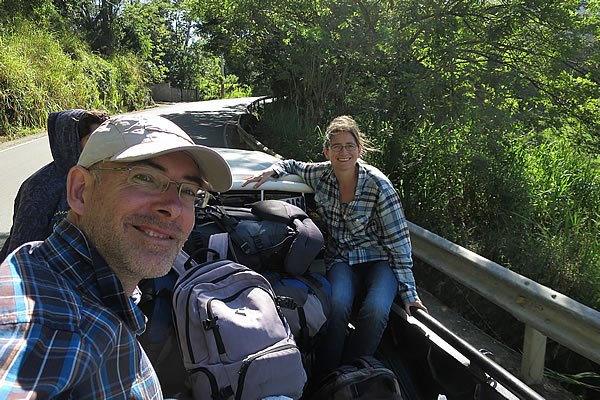 |
|
Travelling by pickup in the hinterland of the Dominican Republic |
|
Jarabacoa is situated at an altitude of 650 meters, making it a bit cooler here than in the lowland cities. Now that we are away from the larger cities, the streets are mostly filled with smelly motorcycles. Children from a young age also ride these from the moment that they are big enough to climb on them. The motoconcho - a motorcycle taxi - is an extremely practical form of public transport here. The only concern that you will have when using it, is that nothing goes wrong, because nobody uses helmets here. The reckless behaviour of the motoconcho drivers undoubtedly contributes to the fact that the Dominican Republic is one of the top 10 countries with the highest number traffic deaths per capita (over 29 per 10,000 inhabitants). 63% of the traffic casualties come from the category of motorcyclists. So when we visit some sights in the beautiful surroundings of Jarabacoa we hold on tightly and just pray that nothing goes wrong. A shared pickup brings us via a beautiful road to Constanza. We are in the back of the pickup truck and enjoy the views. Constanza appears to be an extremely dusty town where the Santo Dominicans arrive in the weekends during the hot season to find some coolness. We visit the park Ebano Verde and make a day trip to Salto de Aguas Blancas. Salto de Aguas Blancas is the highest waterfall in the country and is accessible via a bumpy dirt road. While going to the waterfall by motoconcho, we see beautiful views of mountains with neatly landscaped fields. Because the waterfall is only 18 kilometres away from the town of Constanza, we decide to walk a large part of the way back. This way we can better take in the views. We pass small villages of the farm workers. These farm workers are clearly poor, live in huts made of iron roof plates, and they spend long days in the blazing sun. Many Haitians have come illegally to the Dominican Republic to earn some money here. They work here for low wages on the fields and plantations, but they probably earn more here than that they would earn in Haiti. The poorer Dominican workers see the Haitians as displacers in the labour market who keep wages low: that seems true in a country where labour laws don’t exist or where labour laws are not enforced. The more people competing for a job, the less employers have to pay for their labour. If one person does not want to do the job for a certain wage, the other one does. It is shocking to see that workers are spraying pesticides for hours in a row without any kind of protection for themselves. |
|
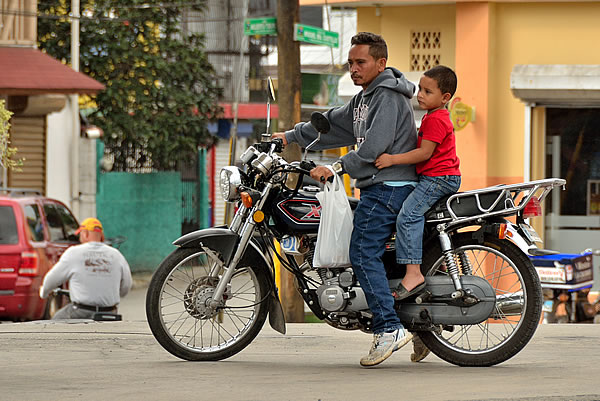 |
|
63% of the traffic deaths in the Dominican Republic are motorcycle related |
|
| From the Central Mountain area we go back to Santo Domingo where we stay a few days before going to the mainland of Central America. During our last trip through Central America we visited Mexico, Guatemala and Belize and now we want to move further south from El Salvador. To get to El Salvador, we found a flight from Santo Domingo to Costa Rica and then, after a 6 hour transfer, to San Salvador. Our flight in Santo Domingo leaves at 5:00 in the morning and we decide to spend the evening in advance at the airport. It is a very long night where we read a lot in our books. After missing a night of sleep we arrive in San Salvador; we are exhausted. After a day of rest in San Salvador we leave immediately for Santa Ana: a colonial town in the northwest of the country. (See also the article about Santa Ana) Santa Ana is a great base for visiting Parque Nacional de Los Volcanes. Here we climb the Santa Ana volcano to enjoy the grandiose views. Highly recommended! We also visit the Mayan city of Tazumal, where you see few other travellers. Honestly, we do understand that tourists skip Tazumal if they have already seen the Maya sites of Guatemala and Mexico. For us as bird watchers, however, it is a beautiful place where we see some beautiful creations of nature. Because the Christmas period is coming we go back to San Salvador. During high season weeks such as the weeks around Christmas and Easter, we usually look for a non-touristy place to wait until the busy time is over. We prefer to be in a "real" city where we have a supermarket, good internet and plenty of places to drink a cup of coffee. San Salvador meets all these requirements and has also a colourful old centre, a beautiful botanical garden and you can easily take the bus to the beach. We visit the city’s sights and work on the website. The photos of the Dominican Republic are uploaded (see here the photo impression) we write articles about the Dominican Republic (see here) and about Santa Ana and make a video clip about the Dominican Republic (video clip). For us, San Salvador is a great place to get some work done, celebrate Christmas and make a good start in 2018. We look forward to what the coming year will bring us and we want to wish everyone well for 2018. |
|
 |
|
Arrival in San Salvador |
|
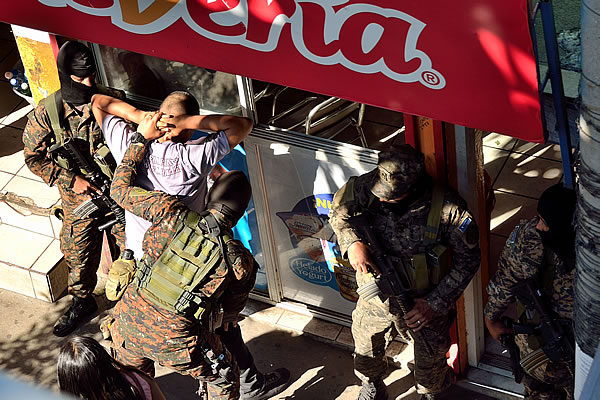 |
|
Unidentifiable sodiers check a man on a bus station in San Salvador |
|
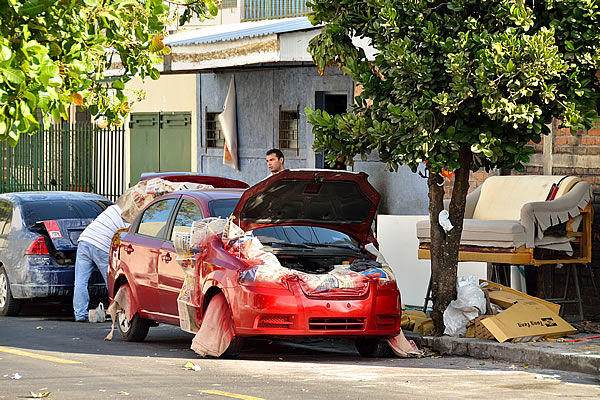 |
|
Painting your car dust free. Why? |
|
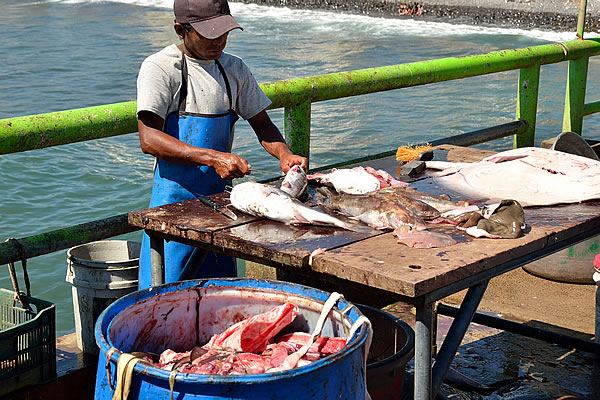 |
|
Cleaning fish in La Libertad (El Salvador)
| |
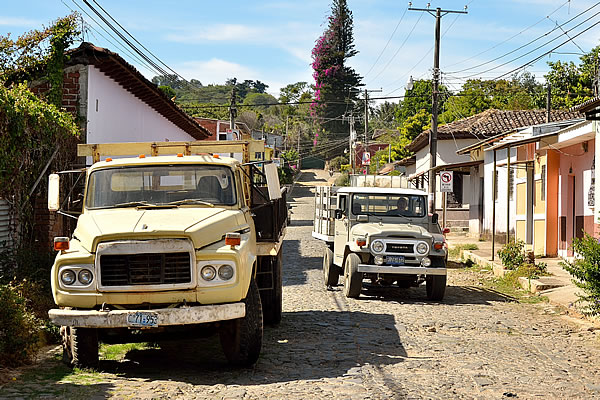 |
|
Rural life in El Salvador's mountain area |
|
| <Previous weblog> | |